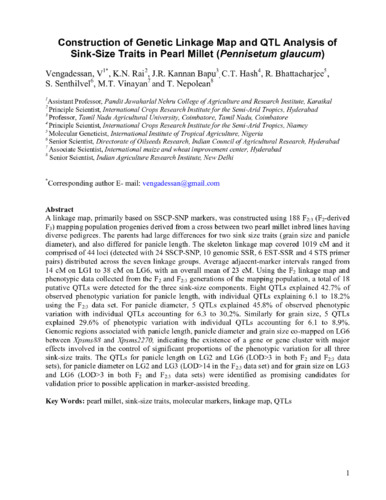Construction of genetic linkage map and QTL analysis of sinksize traits in pearl millet (Pennisetum glaucum)
Abstract
A linkage map, primarily based on SSCP-SNP markers, was constructed using 188 F2:3 (F2-derived F3) mapping population progenies derived from a cross between two pearl millet inbred lines having diverse pedigrees. The parents had large differences for two sink size traits (grain size and panicle diameter), and also differed for panicle length. The skeleton linkage map covered 1019 cM and it comprised of 44 loci (detected with 24 SSCP-SNP, 10 genomic SSR, 6 EST-SSR and 4 STS primer pairs) distributed across the seven linkage groups. Average adjacent-marker intervals ranged from 14 cM on LG1 to 38 cM on LG6, with an overall mean of 23 cM. Using the F2 linkage map and phenotypic data collected from the F2 and F2:3 generations of the mapping population, a total of 18 putative QTLs were detected for the three sink-size components. Eight QTLs explained 42.7% of observed phenotypic variation for panicle length, with individual QTLs explaining 6.1 to 18.2% using the F2:3 data set. For panicle diameter, 5 QTLs explained 45.8% of observed phenotypic variation with individual QTLs accounting for 6.3 to 30.2%. Similarly for grain size, 5 QTLs explained 29.6% of phenotypic variation with individual QTLs accounting for 6.1 to 8.9%. Genomic regions associated with panicle length, panicle diameter and grain size co-mapped on LG6 between Xpsms88 and Xpsms2270, indicating the existence of a gene or gene cluster with major effects involved in the control of significant proportions of the phenotypic variation for all three sink-size traits. The QTLs for panicle length on LG2 and LG6 (LOD>3 in both F2 and F2:3 data sets), for panicle diameter on LG2 and LG3 (LOD>14 in the F2:3 data set) and for grain size on LG3 and LG6 (LOD>3 in both F2 and F2:3 data sets) were identified as promising candidates for validation prior to possible application in marker-assisted breeding.

